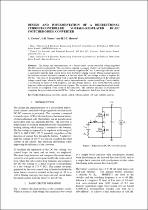 ResearchSpace
ResearchSpace
Design and implementation of a bidirectional current-controlled voltage-regulated DC-DC switched-mode converter
JavaScript is disabled for your browser. Some features of this site may not work without it.
- ResearchSpace
- →
- Research Publications/Outputs
- →
- Conference Publications
- →
- View Item
| dc.contributor.author |
Coetzer, A

|
|
| dc.contributor.author |
Turner, Geoffrey R

|
|
| dc.contributor.author |
Mouton, HDT

|
|
| dc.date.accessioned | 2017-06-07T07:06:29Z | |
| dc.date.available | 2017-06-07T07:06:29Z | |
| dc.date.issued | 2016-01 | |
| dc.identifier.citation | Coetzer, A., Turner, G.R. and Mouton, H.D.T. 2016. Design and implementation of a bidirectional current-controlled voltage-regulated DC-DC switched-mode converter. Southern African Universities Power Engineering Conference (SAUPEC), 26-28 January 2016, Vaal University of Technology, Vanderbijilpark, Gauteng | en_US |
| dc.identifier.uri | http://hdl.handle.net/10204/9149 | |
| dc.description | Southern African Universities Power Engineering Conference (SAUPEC), 26-28 January 2016, Vaal University of Technology, Vanderbijilpark, Gauteng | en_US |
| dc.description.abstract | The design and implementation of a bidirectional current-controlled voltage-regulated DC-DC converter is presented. The converter is required to connect a battery of electrochemical cells (the battery) to an asynchronous motor-drive unit via a regulated DC bus. A two-stage soft-start circuit is included to limit the peak current drawn from the battery during start-up. During normal operation the converter controls the battery current as a function of the DC bus voltage in order to regulate the DC bus. The focus of the presented work is upon the design and implementation of the current and voltage control loops, where the voltage control loop encloses the current control loop. Circuit stability is ascertained by means of both frequency and time domain analysis. It is shown that both control loops are stable and provide good transient response. The presented circuit is manufactured and tested. Test results are compared to the results of the simulation. The converter efficiency is determined by comparing the power drawn from the DC bus (with a load in place) to that drawn from the battery. | en_US |
| dc.language.iso | en | en_US |
| dc.relation.ispartofseries | Worklist;18544 | |
| dc.subject | Bidirectional converter | en_US |
| dc.subject | Current control | en_US |
| dc.subject | Voltage control | en_US |
| dc.subject | Soft-start | en_US |
| dc.subject | Stability analysis | en_US |
| dc.title | Design and implementation of a bidirectional current-controlled voltage-regulated DC-DC switched-mode converter | en_US |
| dc.type | Conference Presentation | en_US |
| dc.identifier.apacitation | Coetzer, A., Turner, G. R., & Mouton, H. (2016). Design and implementation of a bidirectional current-controlled voltage-regulated DC-DC switched-mode converter. http://hdl.handle.net/10204/9149 | en_ZA |
| dc.identifier.chicagocitation | Coetzer, A, Geoffrey R Turner, and HDT Mouton. "Design and implementation of a bidirectional current-controlled voltage-regulated DC-DC switched-mode converter." (2016): http://hdl.handle.net/10204/9149 | en_ZA |
| dc.identifier.vancouvercitation | Coetzer A, Turner GR, Mouton H, Design and implementation of a bidirectional current-controlled voltage-regulated DC-DC switched-mode converter; 2016. http://hdl.handle.net/10204/9149 . | en_ZA |
| dc.identifier.ris | TY - Conference Presentation AU - Coetzer, A AU - Turner, Geoffrey R AU - Mouton, HDT AB - The design and implementation of a bidirectional current-controlled voltage-regulated DC-DC converter is presented. The converter is required to connect a battery of electrochemical cells (the battery) to an asynchronous motor-drive unit via a regulated DC bus. A two-stage soft-start circuit is included to limit the peak current drawn from the battery during start-up. During normal operation the converter controls the battery current as a function of the DC bus voltage in order to regulate the DC bus. The focus of the presented work is upon the design and implementation of the current and voltage control loops, where the voltage control loop encloses the current control loop. Circuit stability is ascertained by means of both frequency and time domain analysis. It is shown that both control loops are stable and provide good transient response. The presented circuit is manufactured and tested. Test results are compared to the results of the simulation. The converter efficiency is determined by comparing the power drawn from the DC bus (with a load in place) to that drawn from the battery. DA - 2016-01 DB - ResearchSpace DP - CSIR KW - Bidirectional converter KW - Current control KW - Voltage control KW - Soft-start KW - Stability analysis LK - https://researchspace.csir.co.za PY - 2016 T1 - Design and implementation of a bidirectional current-controlled voltage-regulated DC-DC switched-mode converter TI - Design and implementation of a bidirectional current-controlled voltage-regulated DC-DC switched-mode converter UR - http://hdl.handle.net/10204/9149 ER - | en_ZA |





